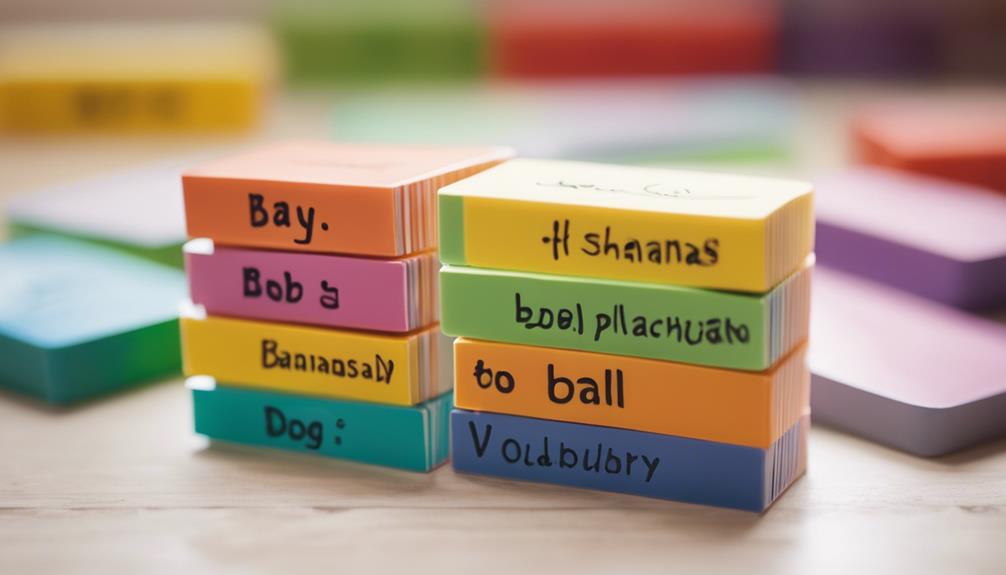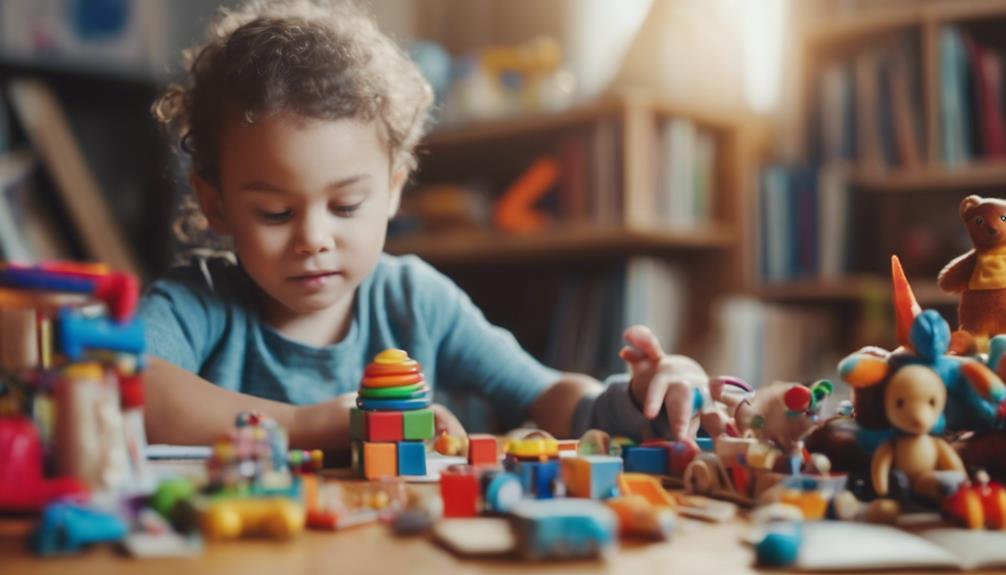When teaching your baby, make early learning strategies a priority to establish a solid foundation for cognitive and social development. Utilize Developmentally Appropriate Practices (DAP) to customize educational experiences based on your baby’s needs and abilities effectively. Create engaging learning environments with vibrant play areas and interactive tools to encourage visual and cognitive development. Consistent routines and a safe environment help build trust and foster social development in babies. Enhance cognitive growth by including stimulating activities and promoting language development through interactive conversations. By focusing on early learning strategies, you can enhance your baby’s overall development and pave the way for future success.
Key Takeaways
- Engage in frequent verbal interactions to build vocabulary and stimulate cognitive growth.
- Utilize interactive toys like shape sorters for problem-solving development.
- Read books and sing songs to introduce varied vocabulary and promote language skills.
- Encourage tummy time and provide safe spaces for physical development.
- Model positive behaviors to teach social skills and support emotional development.
Importance of Early Learning
Understanding the significance of early learning is essential for laying a strong foundation for your baby's cognitive and social development. Early childhood educators play an important role in creating enriching environments that stimulate young minds and foster growth.
Research highlights the profound impact that quality early learning experiences have on brain development, shaping a child's cognitive abilities and future learning potential. Children who participate in well-designed early learning programs demonstrate higher academic achievement and enhanced social skills as they progress through life.
Early learning opportunities provide a platform for children to develop essential language, literacy, and numeracy skills, which are fundamental for future academic success. Additionally, quality early learning environments support social-emotional development by nurturing empathy, effective communication, and conflict resolution skills.
Understanding Developmentally Appropriate Practices (DAP)

Understanding Developmentally Appropriate Practices (DAP) is vital in tailoring educational experiences to suit children's unique needs. By adhering to DAP principles, you guarantee that activities aren't only age-appropriate but also align with individual capabilities.
Implementing DAP strategies fosters a nurturing environment where children can thrive and develop essential skills.
DAP Principles Overview
To effectively implement Developmentally Appropriate Practices (DAP) in early childhood education, tailor your teaching methods to match the age, individual needs, and developmental stage of each child. DAP principles emphasize active engagement, hands-on learning, and meaningful experiences. By creating a nurturing and inclusive environment that respects children's cultural backgrounds and abilities, educators can support their growth and development effectively. Providing appropriate challenges allows children to learn and grow at their own pace, fostering a sense of accomplishment and confidence. Aligning with research-based best practices, DAP guarantees that early childhood education is both engaging and beneficial for young learners.
| DAP Principles Overview |
|---|
| Tailor teaching methods to match each child's age, needs, and stage of development |
| Promote active engagement and hands-on learning |
| Create a nurturing and inclusive environment |
| Provide appropriate challenges for individual growth |
Benefits of DAP
Tailor your teaching strategies to match the developmental stage of each child, benefiting their overall learning experience through Developmentally Appropriate Practices (DAP).
By implementing DAP principles with young children, you create an environment where learning is both challenging and achievable, aligning with their current abilities. DAP takes into account the unique strengths, interests, and cultural backgrounds of each child, fostering a more personalized and effective learning journey.
This approach encourages a holistic view of education, addressing not only cognitive development but also social, emotional, and physical growth.
One significant benefit of DAP is the enhanced engagement and motivation it brings to young learners. When teaching practices are tailored to suit the developmental readiness of children, they're more likely to be actively involved in the learning process, leading to improved outcomes.
Ultimately, DAP helps create a supportive and enriching educational experience that caters to the diverse needs of young children, setting a solid foundation for their future learning and development.
Implementing DAP Strategies
Create a dynamic learning environment by implementing DAP strategies that cater to the unique developmental needs of each child. Children learn best when instruction is tailored to their specific age, developmental stage, and individual requirements.
DAP strategies, grounded in research on how young children learn and grow, emphasize hands-on activities that engage learners actively. By incorporating DAP principles, educators can foster a nurturing setting that supports children's social, emotional, cognitive, and physical development.
These strategies enable teachers to scaffold learning experiences effectively, providing challenges that are appropriate for each child's stage of development. Implementing DAP guarantees that teaching practices are responsive, respectful, and conducive to promoting children's overall well-being and learning outcomes.
Understanding and applying DAP strategies reflect a commitment to creating an environment where each child can thrive and reach their full potential. By embracing DAP, educators can enhance the educational journey of every child in their care.
Creating Engaging Learning Environments

When creating engaging learning environments for infants and toddlers, it's crucial to prioritize the use of colorful play spaces and interactive learning tools.
Soft colors and varied textures can stimulate sensory exploration, while a print-rich environment with labels, pictures, and books promotes language development.
Colorful Play Spaces
Enhance your baby's early learning experiences by surrounding them with colorful play spaces that stimulate their visual development and engage their senses from a young age.
Infants and toddlers benefit greatly from environments rich in a variety of colors, as this can promote cognitive development and ignite curiosity. Bright and vibrant colors not only enhance mood but also create a welcoming and stimulating atmosphere that's conducive to learning.
By incorporating contrasting colors, babies can start distinguishing between different objects, aiding in the development of visual discrimination skills. These colorful play spaces serve as the perfect backdrop for infants to explore, play, and learn through sensory experiences.
The visual stimulation provided by the colors helps in capturing their attention and encouraging interaction with their surroundings. Creating an environment filled with a diverse palette of colors can set the stage for a vibrant and engaging learning experience for your little one.
Interactive Learning Tools
Engage your baby in stimulating environments by incorporating interactive learning tools such as sensory toys, musical instruments, and colorful visuals. These interactive learning tools provide essential multi-sensory experiences that are vital for enhancing cognitive development in infants. Textured materials, music, and movement offered through these tools can help in stimulating your baby's senses and fostering early learning.
To further support your baby's development, make sure to provide age-appropriate toys and objects that encourage exploration, problem-solving, and fine motor skills development. Creating interactive spaces with mirrors, soft play areas, and stimulating mobiles can promote sensory exploration and body awareness in your little one.
Additionally, incorporating technology-based interactive tools like educational apps and interactive books can introduce your baby to early learning concepts in engaging ways. By offering a variety of interactive learning tools, you can create a rich learning environment that nurtures your baby's development and curiosity.
Building Positive Relationships

Fostering positive relationships with babies is essential for their social-emotional development and overall well-being.
Responsive child care, such as promptly meeting a baby's needs, plays an important role in strengthening the bond between caregiver and baby.
Engaging in playful interactions, like peek-a-boo or gentle tickling, fosters trust and attachment with the baby.
Consistent routines and a secure environment can help babies feel safe and develop a sense of trust in their caregivers.
It's critical to show affection through cuddles, smiles, and positive verbal interactions to create a loving and nurturing relationship with the baby.
These actions not only promote emotional well-being but also lay the foundation for healthy social development in the future.
Promoting Cognitive Development

To support babies' cognitive development, incorporate stimulating activities that engage their senses and promote brain growth. Engage babies in sensory play activities that involve textures, colors, and sounds to stimulate their brain development.
Use simple cause-and-effect toys like stacking cups or pop-up toys to help babies understand relationships between actions and outcomes. Encourage cognitive development by talking to babies frequently, describing the world around them, and building their vocabulary through exposure to new words.
Introduce shape sorters and stacking toys to promote problem-solving skills and spatial awareness in babies as they learn to categorize shapes and sizes. Additionally, incorporating interactive books and picture cards can enhance babies' cognitive skills through visual stimulation and exposure to early literacy.
Professional development in this area can provide caregivers with the knowledge and skills needed to create enriching environments that support babies' cognitive growth effectively. These strategies are essential in laying a strong foundation for lifelong learning and intellectual development.
Fostering Language Development

Regularly engaging in responsive conversations with your baby is essential for fostering their language development from an early age. By providing abundant access to language-rich interactions, you can greatly support your baby's language skills.
Here are some effective strategies to help nurture your baby's language development:
- Utilize descriptive language, gestures, and facial expressions to enhance communication with your infant.
- Read books and sing songs to expose your baby to varied vocabulary and language patterns.
- Respond promptly to your baby's sounds and attempts at communication to encourage language exploration.
- Create a language-rich environment by labeling objects, describing actions, and engaging in interactive play with your baby.
These approaches not only stimulate your baby's language acquisition but also strengthen your bond through meaningful interactions. Remember, the more you engage your baby in language-rich activities, the more you're helping to lay a solid foundation for their future linguistic abilities.
Enhancing Social-Emotional Skills

Engage with your infant in meaningful interactions to enhance their social-emotional skills from an early age. Acknowledge and praise their positive actions to boost self-esteem and promote continued positive behaviors.
By modeling desired behavior, you can teach social skills through example, fostering empathy and understanding in your baby. Provide support at the edge of their competence level during challenging tasks to boost their confidence through guided practice.
Focus on developing emotional regulation and self-expression skills to help build strong social-emotional competencies in your infant. Encouraging meaningful interactions and nurturing relationships will create an environment that supports their social-emotional development.
Supporting Physical Development

Strengthen your baby's physical development by encouraging tummy time to build neck and shoulder muscles. This activity supports the development of head control, which is essential for eventual rolling over.
In addition to tummy time, there are various ways you can further enhance your baby's physical development:
- Provide opportunities for reaching and grasping objects to improve fine motor skills and hand-eye coordination.
- Incorporate sensory play activities that involve exploring different textures and materials to stimulate sensory development and cognitive growth.
- Support gross motor skills by creating safe spaces for crawling, cruising, and walking, which help build physical strength and coordination.
- Offer interactive play with toys designed to encourage movement, such as balls for rolling or push toys for walking practice, to foster physical development and coordination.
Evaluating Progress and Adjusting Strategies

Assess children's developmental progress through observation and documentation to effectively evaluate their growth and learning. Utilize assessment tools to track milestones and identify areas for improvement. Share assessment information with families to guarantee a collaborative approach to learning. Adjust teaching strategies based on assessment data to meet individual needs effectively. Continuous professional development for educators enhances evaluation practices and supports children's growth.
| Assessment Data | Description |
|---|---|
| Observations | Regularly observe children to gather data on their developmental progress. |
| Documentation | Keep detailed records of children's achievements and areas needing improvement. |
| Milestone Tracking | Use assessment tools to track developmental milestones and growth. |
| Family Communication | Share assessment information with families to foster collaboration in supporting children's learning. |
| Strategy Adjustment | Modify teaching strategies based on evaluation data to cater to individual needs effectively. |
Regularly evaluating children's progress through various means allows educators to tailor their teaching strategies effectively. Sharing evaluation data with families promotes a collaborative approach to support children's overall development.
Frequently Asked Questions
What Are the Teaching Strategies of an Infancy?
In infancy, teaching strategies involve nurturing sensory exploration, fostering cognitive development, and promoting responsive caregiving. Encourage consistent interactions, provide a language-rich environment, and offer a safe, stimulating space for best growth.
How Can I Teach My Baby Early?
You can teach your baby early by engaging in daily activities, using simple language, providing sensory experiences, reading books, and creating a safe environment for exploration. These strategies promote bonding, language development, and cognitive skills.
What Are the 5 Teaching Strategies for Preschoolers?
Explore hands-on activities, use visual aids, promote social interactions, establish routines, and provide positive reinforcement to engage and educate preschoolers effectively. Engage them in learning through play and interaction to foster their development.
What Is the Most Effective Way Infants Learn?
Babies learn best through sensory experiences, social interactions, routines, and imitation. Their rapid brain development is influenced by environmental stimuli. Consistent routines and enriching experiences support their learning process, helping to form essential neural connections for growth.
Conclusion
To sum up, the early learning strategies outlined in this article serve as a foundational framework for helping babies develop essential skills.
By embracing developmentally appropriate practices, creating engaging environments, and fostering positive relationships, caregivers can support the cognitive, language, social-emotional, and physical development of infants.
Remember, the journey of teaching a baby is a marathon, not a sprint. Stay patient, remain consistent, and be open to adjusting your approach as needed.
Your dedication will shape the future of these young minds.










